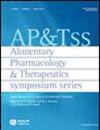Infliximab regulates lamina propria T lymphocytes in patients with Crohn's disease
Abstract
Summary
Background and Aims
The immune system is a major determinant of the pathophysiological inflammation, which may lead to gastrointestinal mucosal injury in patients with Crohn's disease. Cytokines such as tumour necrosis factor-alpha are well-known mediators of the immune system, and treatment with a chimeric anti-tumour necrosis factor-alpha antibody (infliximab) has been shown to be highly effective in patients with Crohn's disease. Recent evidence indicates that infliximab induces apoptosis in lamina propria T lymphocytes in these patients. To better understand the mechanisms of infliximab's effect on gastrointestinal inflammation, we investigated changes in the serum level of cytokines after treatment in these patients, and the effect of infliximab in inducing the apoptosis of T lymphocytes.
Methods
Thirteen patients with Crohn's disease were treated with infliximab at a dosage of 5-mg/kg body weight. Clinical response was evaluated using the Crohn's Disease Activity Index, and serum soluble interleukin-2 receptor, interleukin-6, tumour necrosis factor-alpha levels were analysed by enzyme-linked immunosorbent assay at 0 and 2 weeks after treatment. Apoptosis of peripheral and lamina propria T lymphocytes after culture with infliximab was detected by flow cytometry.
Results
Crohn's Disease Activity Index decreased in 12 of 13 patients, and serum soluble interleukin-2 receptor, interleukin-6 and tumour necrosis factor-alpha levels decreased in most patients after treatment with infliximab. Tumour necrosis factor-alpha level before treatment in the six patients in whom Crohn's Disease Activity Index decreased by more than 70 was <5 ng/mL. Infliximab induced the apoptosis of lamina propria but not of peripheral T lymphocytes.
Conclusion
These findings suggest that a low level of serum tumour necrosis factor-alpha is an indicator for infliximab treatment. The induction of apoptosis of lamina propria T lymphocytes by infliximab may be an important mechanism of its anti-inflammatory effect in patients with Crohn's disease.

 求助内容:
求助内容: 应助结果提醒方式:
应助结果提醒方式:


